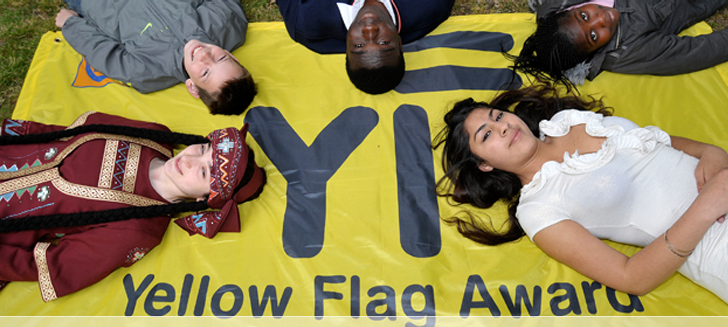Mags Gargan looks at a programme that promotes diversity in schools
‘The biggest success of all was the attitude change in the students. This programme opened their eyes to a world of cultures and languages,” says Melissa Boyer, of the experience of St Joseph’s Girls National School in Dublin’s Finglas on participating in the Yellow Flag Awards.
The awards programme is offered by the Irish Traveller Movement and provides a practical series of eight steps that brings issues of interculturalism, equality and diversity into the whole school programme and involves students, staff, management, parents and wider community groups.
The project was inspired by the green schools model where both primary and secondary schools complete a series of stages to achieve a green flag as part of an environmental education programme.
The yellow flag steps range from intercultural and anti-racism training for staff and management, to establishing a diversity committee and producing a diversity code and anti-racist policy for the school.
”In our work with the Irish Traveller Movement, we were very conscious that for a lot of young travellers, school wasn’t a very positive place and a lot of the issues that continue to come up were that Travellers had felt that they had to hide their identity in school, or that they never got an opportunity to have their identity affirmed and celebrated in the school,” says Paula Madden, the yellow flag co-ordinator.
Solidarity
”We worked in solidarity with other groups and we realised that we didn’t want this just to be about the inclusion of Travellers, but to be about the inclusion of all children — that it would have a particular focus on students from ethnic minorities and other cultures and religious faiths.”
The project was piloted in four schools in 2008/2009, which led to a research report and a handbook for future schools taking part in the programme. Another four schools had a pilot last year and there are now nine schools taking part this year. This may sound like a small number but this is down to funding levels rather than a lack of interest.
”We were lucky enough to get a grant from a philanthropic body called the Community Foundation for Ireland and they supported us with a strategic grant to look at trying to develop partners with some of the key agencies and to look at trying to mainstream the programme,” says Paula.
Presenting the Yellow Flag Awards last year, the then President-elect Michael D. Higgins said it was a ”marvellous initiative”.
”The Yellow Flag Awards emphasise the central importance of recognising, on equal terms, the dignity and contribution of each person in differing circumstances and with different cultural experiences — they are a marker of respect.”
Margaret Alyward Community College in Dublin received their flag that day and the programme’s link teacher Emily Dunleavy says the yellow flag committee is still active and very enthusiastic.
Positive
”One of the girls on the committee is Roma, and it has been such a positive experience for her,” Emily says.
”We have about 25-26 different nationalities in the school and we always had a commitment to diversity and celebrated an intercultural day, but we wanted to get involved in yellow flag to get the recognition and to do more on interculturalism.
”We have a lot of Roma students and the girls weren’t integrating as much as other minority groups. Their experience has really improved, because other students understand them more and accept them better.”
Aston Village Educate Together school in Drogheda has children from 30 different nationalities and about seven per cent are from the Travelling Community so principal John Kelleher says the yellow flag programme was a ”good fit” for them.
”Our difference is our strength and as a celebration of that the yellow flag programme is very worthwhile,” he says. ”It is very well laid out and if you follow the steps — it ticks all the boxes for us as an Educate Together school.”
Paula Madden says that for many schools the programme offers a framework for the diversity work that they were already doing or that they wanted to do.
”It gives a really good framework for developing this work. Even schools that are very proactive around integration have been surprised at stuff that has come up, or things that they didn’t know that students felt.
”I think because it’s a very whole school approach, and students are learning about other cultures, they won’t just learn about one particular culture or nationality, they learn about all of the cultures and nationalities that are represented in the school.
(Pictured: Students from Margaret Aylward Community College, with teacher Emily Dunleavy receiving the Yellow Flag Award 2011 from President Michael D. Higgins.)
Boundaries
”That really breaks down some of the boundaries that might have been there before where they felt that there was mistrust between different groups within the school, and many more friendships are formed.”
Paula says that from the point of view of students from minority groups, they felt they did not have to explain themselves anymore, and that other students felt that they could ask questions that they may have been afraid to ask for fear of causing offence.
”Students themselves feel that their own identity is more affirmed, and that students from other nationalities and cultures are more affirmed within that school.
”Intercultural days have now become an annual event and there’s a great buzz and a great sense of pride within all the students during those days, which is fantastic.”
”The programme did a lot for the students on a personal level,” says Melissa Boyer.
”We noticed especially with the girls on the committee how their self esteem and confidence soared during the year.
”As well as that, some students who once had felt isolated were now given a voice and an opportunity to share their proud culture with their friends.”


 Mags Gargan
Mags Gargan
